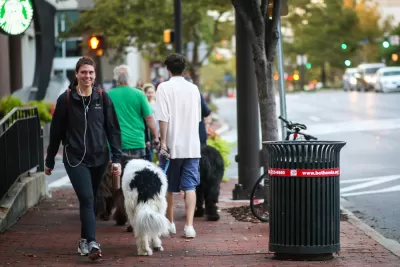The draft new Montgomery County Complete Streets design guide is a key tool for achieving the goals set out by the county's Vision Zero Action Plan.

Montgomery County, Maryland recently released the draft Montgomery County Complete Streets design guide ahead of a public review process expected to culminate before the County Council in January 2021.
"Complete Streets are roadways that are designed and operated to provide safe, accessible, and healthy travel for all users of the roadway system, including pedestrians, bicyclists, transit riders, and motorists," according to the Montgomery Planning website that shares the draft.
According to the website, the Design Guide is designed to offer flexibility to the various communities in the county while adhering to three principles: safety, sustainability, and vitality. The Complete Streets Design Guide is intended to further the county's Vision Zero goals to reduce traffic fatalities.
Given the current debate about the centering of equity in transportation planning and the need for planners to address the lack of safety for people of color while traveling on every available mode of transportation, I did a quick search and found only two uses of the word equity—both times mentioning that traffic collisions disproportionately affect people of color, but in neither case offering any specifics about how the deployment of complete streets principles for the Vision Zero agenda would address disparities in traffic safety or access to mobility.
The history of planning in Montgomery County is fraught with criticisms of discriminatory practices, but some local officials and advocates have been moving the needle toward equity in recent months.
FULL STORY: Complete Streets Design Guide

Alabama: Trump Terminates Settlements for Black Communities Harmed By Raw Sewage
Trump deemed the landmark civil rights agreement “illegal DEI and environmental justice policy.”

Planetizen Federal Action Tracker
A weekly monitor of how Trump’s orders and actions are impacting planners and planning in America.

The 120 Year Old Tiny Home Villages That Sheltered San Francisco’s Earthquake Refugees
More than a century ago, San Francisco mobilized to house thousands of residents displaced by the 1906 earthquake. Could their strategy offer a model for the present?

In Both Crashes and Crime, Public Transportation is Far Safer than Driving
Contrary to popular assumptions, public transportation has far lower crash and crime rates than automobile travel. For safer communities, improve and encourage transit travel.

Report: Zoning Reforms Should Complement Nashville’s Ambitious Transit Plan
Without reform, restrictive zoning codes will limit the impact of the city’s planned transit expansion and could exclude some of the residents who depend on transit the most.

Judge Orders Release of Frozen IRA, IIJA Funding
The decision is a victory for environmental groups who charged that freezing funds for critical infrastructure and disaster response programs caused “real and irreparable harm” to communities.
Urban Design for Planners 1: Software Tools
This six-course series explores essential urban design concepts using open source software and equips planners with the tools they need to participate fully in the urban design process.
Planning for Universal Design
Learn the tools for implementing Universal Design in planning regulations.
Clanton & Associates, Inc.
Jessamine County Fiscal Court
Institute for Housing and Urban Development Studies (IHS)
City of Grandview
Harvard GSD Executive Education
Toledo-Lucas County Plan Commissions
Salt Lake City
NYU Wagner Graduate School of Public Service





























